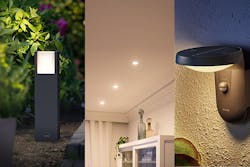With global energy prices soaring, Signify has upped the ante on its “Ultra Efficient” line of LEDs, adding twelve new lamps and luminaires that it says are as much as 50% more efficient than its standard LED offerings.
Although the new models are aimed primarily at the consumer market — where Signify sales have slumped — they cross over to some extent into the professional sector.
“With the price of energy today, if you can save 50%, the return on investment for the solution is much faster than ever before,” Signify CEO Eric Rondolat told analysts on a recent web call to discuss third-quarter results. “So we get a traction which is pulling to the new technology, not only compared to conventional, but compared also to existing LED.”
Signify first introduced the Philips brand Ultra Efficient line in August 2021 with 40W- and 60W-equivalent lamps, citing a 60% improvement in energy efficiency. At the time, LEDs Magazine pointed out that the improvement seemed to even exceed 60% in some cases. Signify said then that it was stating 60% — and not higher — to avoid issuing misleading information.
The company is now adding higher wattage-equivalent products but has lowered its general claim to 50%, which would still represent a significant advance. (It added an Ultra Efficient tube earlier this year, stating a 44% improvement over existing LED tubes including its own).
“Now we are extending the Ultra Efficient range to more wattage, form factors, also launching Ultra Efficient luminaires,” a Signify spokesperson explained to LEDs Magazine. “Not all products have equal saving, and the percentage of energy saving also depends on the energy consumption of equivalent standard Philips LED products, so for the sake of consistency and clarity, we’re using the 50% figure for all.”
As Signify expands the line, one thing has remained the same: It is selling the lamps at a premium, well above the price of existing products, which it continues to sell.
In August 2021, the new lamps were selling at around 2.5 times the price of standard LED lamps. The delta might now be a little less.
“As a rough guide, most retailers position the luminaires, for example, at around 1.5 the ‘standard LED alternatives,’ and the lamps at around 2 times,” the spokesperson said. “The new products carry a price premium (which varies from product to product), reflecting our investment in innovation. While there is a premium over ‘standard LED’ products, the Ultra Efficient range offers substantial energy savings.”
The company did not reveal the method by which it has gained energy efficiency.
However, the new products come with a compromise in light quality, as Signify offers them with color temperature ratings of 3000K and 4000K “in most ranges,” the spokesperson said. In the Kelvin scale, those lamps are cooler than the 2700K that Signify offers on existing LED lamps; some vendors claim 2300K. Many home users — although not all, and it varies across geographies — prefer warmer CCTs.
In an LEDs Magazine spot check on the web, Amazon’s U.K. site was selling an Ultra Efficient 40W-equivalent lamp for £9 (about $10) rated at a cool 4000K. It was offering a 40W standard Philips LED lamp, at the noticeably warmer temperature of 2700K, for £5.53 (about $6.25).
Signify began rolling out the new Ultra Efficient models in European countries last week, and might eventually make them available outside Europe.
“Last year, we launched the first A-class bulb as 40W and 60W equivalent, and now we are expanding the range to both clear and frosted bulbs, and with more wattages as well,” the spokesperson said. “We are also adding different form factors to the ranges, like candles and spots.”
The new products include two indoor Diamond Cut luminaires; two outdoor Arbour luminaires; two outdoor solar-powered Tyla luminaires; four standard shaped lamps at 40W, 60W, 75W, and 100W equivalents; a 40W-equivalent candle lamp; and a 50W-equivalent spot lamp.
*Currency exchange rates current to time of publication.
MARK HALPER is a contributing editor for LEDs Magazine, and an energy, technology, and business journalist ([email protected]).
For up-to-the-minute LED and SSL updates, follow us on Twitter. You’ll find curated content and commentary, as well as information on industry events, webcasts, and surveys on our LinkedIn page and our Facebook page.

Mark Halper | Contributing Editor, LEDs Magazine, and Business/Energy/Technology Journalist
Mark Halper is a freelance business, technology, and science journalist who covers everything from media moguls to subatomic particles. Halper has written from locations around the world for TIME Magazine, Fortune, Forbes, the New York Times, the Financial Times, the Guardian, CBS, Wired, and many others. A US citizen living in Britain, he cut his journalism teeth cutting and pasting copy for an English-language daily newspaper in Mexico City. Halper has a BA in history from Cornell University.





